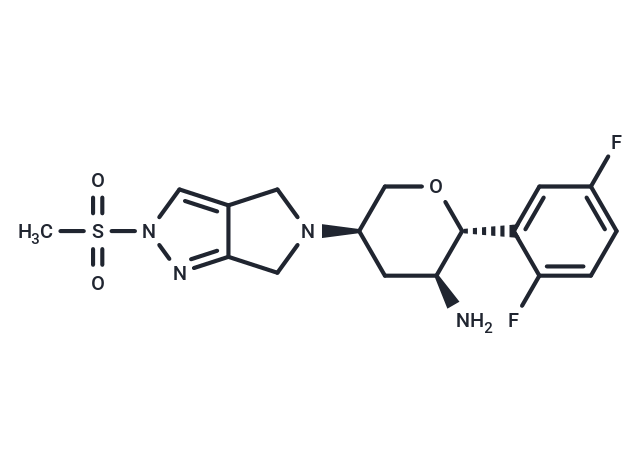Shopping Cart
- Remove All
 Your shopping cart is currently empty
Your shopping cart is currently empty

Omarigliptin is a potent and selective oral dipeptidyl peptidase 4 (DPP4) inhibitor with IC50 value of 1.6 nM. [3]

| Pack Size | Price | Availability | Quantity |
|---|---|---|---|
| 1 mg | $34 | In Stock | |
| 2 mg | $48 | In Stock | |
| 5 mg | $77 | In Stock | |
| 10 mg | $126 | In Stock | |
| 25 mg | $223 | In Stock | |
| 50 mg | $369 | In Stock | |
| 100 mg | $531 | In Stock | |
| 500 mg | $1,180 | In Stock | |
| 1 mL x 10 mM (in DMSO) | $140 | In Stock |
| Description | Omarigliptin is a potent and selective oral dipeptidyl peptidase 4 (DPP4) inhibitor with IC50 value of 1.6 nM. [3] |
| Targets&IC50 | DPP4:1.6 nM |
| In vitro | METHODS: HrGECs cells were stimulated with 0, 1, 2, 10, 20, 100 and 200 μM Omarigliptin for 24 hours and cell viability was observed. RESULTS When the concentration of Omarigliptin was 100 and 200 μM, the viability of HrGECs cells decreased significantly. [2] |
| In vivo | METHODS: A diabetic mouse model was established by treating with streptozotocin (STZ). Omarigliptin (2.5, 5 mg/kg, oral) was used to investigate the effects of Omarigliptin on glucose and insulin levels, cognitive dysfunction, oxidative stress, SIRT3 and FOXO3a expression, and NAD/NADH activity in STZ-induced diabetic mice. RESULTS Omarigliptin can significantly reduce blood glucose in STZ-induced diabetic mice, accompanied by increased serum insulin levels; Omarigliptin improves cognitive dysfunction in STZ-induced diabetic mice; Omarigliptin treatment rescues GSH in the hippocampus in a dose-dependent manner; Omarigliptin induces increased SIRT3 expression and prevents FOXO3a acetylation. [1] |
| Alias | MK-3102 |
| Molecular Weight | 398.43 |
| Formula | C17H20F2N4O3S |
| Cas No. | 1226781-44-7 |
| Smiles | CS(=O)(=O)n1cc2CN(Cc2n1)[C@H]1CO[C@@H]([C@@H](N)C1)c1cc(F)ccc1F |
| Relative Density. | 1.61 g/cm3 (Predicted) |
| Storage | Powder: -20°C for 3 years | In solvent: -80°C for 1 year | Shipping with blue ice. | |||||||||||||||||||||||||||||||||||
| Solubility Information | DMSO: 50 mg/mL (125.49 mM) | |||||||||||||||||||||||||||||||||||
Solution Preparation Table | ||||||||||||||||||||||||||||||||||||
DMSO
| ||||||||||||||||||||||||||||||||||||

Copyright © 2015-2024 TargetMol Chemicals Inc. All Rights Reserved.